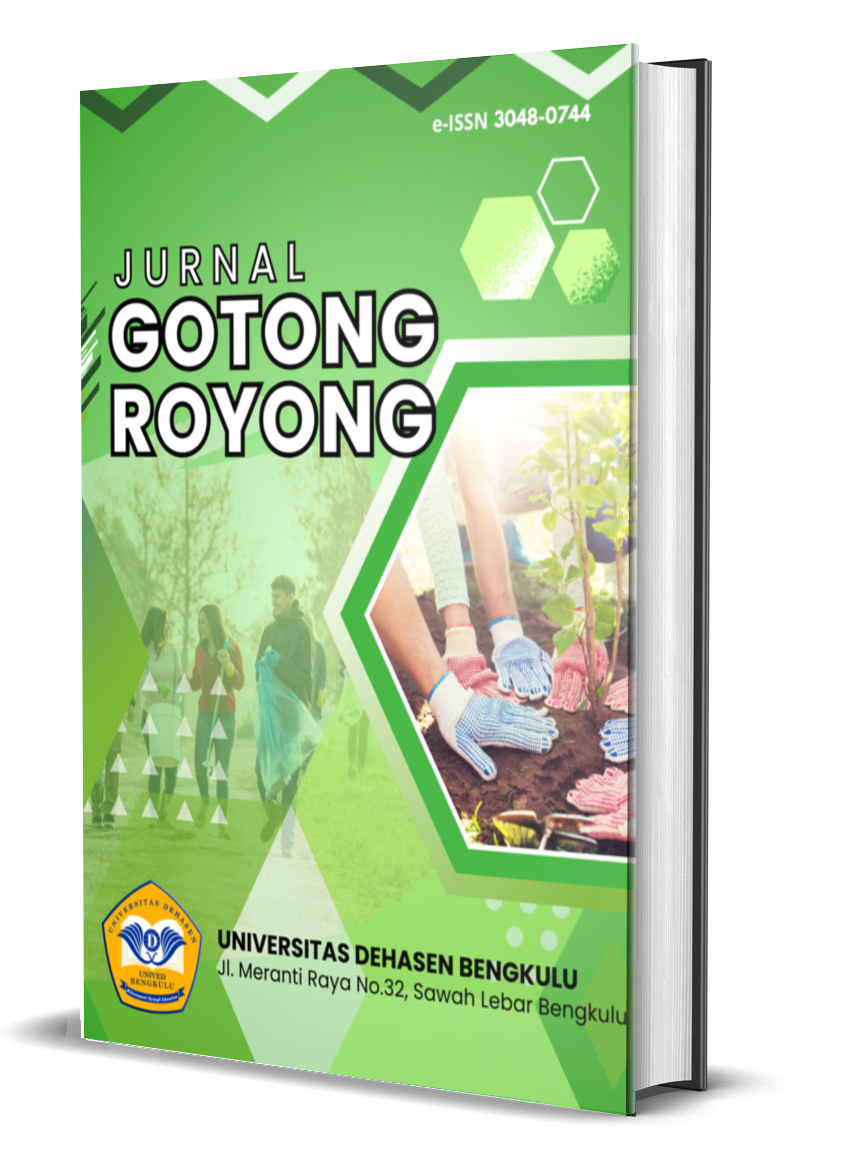Pemanfaatan Sampah Botol Plastik Bekas Sebagai Media Tanam (Pot) Pada Masyarakat Di RT 17 Kel. Pematang Gubernur
Abstract
Plastic waste is a major problem in Indonesia that contributes to environmental damage. This is due to the increasing demand for plastic in line with population growth and the lack of public awareness regarding the reuse of plastic waste. Plastic is indeed one of the biggest 'enemies' of the environment, with used beverage bottles being one of them. As is known, plastic has a negative impact on the environment because plastic is difficult to decompose by the soil even after being buried for years. One simple way that can be implemented in elementary schools to raise students' awareness of the environment is by using used plastic bottles as planting media. This activity aims to raise public awareness about reducing household waste. In addition, another goal is to utilize household waste for something more beneficial, in this case, as a planting medium. This method is carried out through counseling and the distribution of leaflets. The implementation of community service activities related to the management of inorganic household waste into planting media has been carried out well and smoothly. The understanding of the community in RT 17 Pematang Gubernur regarding the management of inorganic waste as a planting medium has increased.
Downloads
References
2. Mukhlidin Mukhlidin, Alfin Muslikhun, Rowiyani Rowiyani, Jayus Jayus, Iqbal Maulana, & Nita Nurmawati. (2023). Pemanfaatan Botol Plastik Bekas Sebagai Media Penanaman Bibit Tanaman pada Ibu-Ibu Pkk Desa Wonolopo, Mijen. Faedah : Jurnal Hasil Kegiatan Pengabdian Masyarakat Indonesia, 1(3), 266–273. https://doi.org/10.59024/faedah.v1i3.1074
3. Munawarah, J. M. A., Arifuddin, M. A., Osman, W. W., Lakatupa, G., Ekawati, S. A., Wahyuni, S., Zaira, M. R., & Hidayah, N. (2024). Pengelolaan Sampah Rumah Tangga sebagai Wujud Implementasi Pembangunan Berkelanjutan di Kelurahan Laikang, Kecamatan Biringkanaya, Kota Makassar. Jurnal Tepat (Teknologi Terapan Untuk Pengabdian Masyarakat), 7(1), 54–63.
4. Muthmahinna, Sari, N., Hayani, N., Nur Putriani Firmansyah, N. R. R., & Fadhilah, N. (2024). OPTIMALISASI PEMA N FAATA N SAMPAH A N ORGA N IK SEBAGAI MEDIA TA N AM BUDIDAYA TA N AMA N OBAT KELUARGA DALAM. Communnity Development Journal, 5(6), 11208–11214.
5. Ribka, M., Fahresi, A., Alrazid, H., Arjun, A., & Astuti Assana, F. (2023). Upaya Mengurangi Limbah Botol Plastik Dengan Cara Mengolahnya Menjadi Kerajinan Bunga. Communnity Development Journal, 4(4), 8223–8227.
6. Ridwan, I., Nurfaida, & Mantja, K. (2017). Pemanfaatan Sampah Anorganik Menjadi Produk Berdaya Guna. Jurnal Dinamika Pengabdian (JDP), 1(2), 123–133. https://journal.unhas.ac.id/index.php/jdp/article/view/2196
7. Sya’bani, N. L., Saktiawan, Y., & Wahyuni, I. D. (2024). Pengaruh Pengelolaan Sampah Reduce Recycle Terhadap Pengurangan Volume Sampah Menuju Tpa Di Tps3R Mitra Patemon. Jurnal Kesehatan Tambusai, 5(3), 8856–8867.
8. Wahida, A. N., Fadarsani, D. N., Astuti, R. D., Rohadatul‘Aisy, R., Tullazulfa, F., Larasaty, T., Indriyani, R., Suyanto, A., & Muryani, S. (2025). Pemanfaatan Daur Ulang Sampah Anorganik Dalam Pengembangan Taman Toga: Solusi Ramah Lingkungan Dusun Kopen, Podosoko, Sawangan, Magelang. JGEN: Jurnal Pengabdian Kepada Masyarakat, 3(3), 298–304.
Copyright (c) 2025 Melsa Wulandari, Sinta Bela, Bella Augusta, Tiara Elma Fira, Asty Eka Fitriani, Iswidana Utama Putra, Yusuf Wahyudi, Tito Irwanto

This work is licensed under a Creative Commons Attribution-ShareAlike 4.0 International License.
An author who publishes in the Jurnal Gotong Royong agrees to the following terms:
Author retains the copyright and grants the journal the right of first publication of the work simultaneously licensed under the Creative Commons Attribution-ShareAlike 4.0 License that allows others to share the work with an acknowledgement of the work's authorship and initial publication in this journal
Submission of a manuscript implies that the submitted work has not been published before (except as part of a thesis or report, or abstract); that it is not under consideration for publication elsewhere; that its publication has been approved by all co-authors. If and when the manuscript is accepted for publication, the author(s) still hold the copyright and retain publishing rights without restrictions. For the new invention, authors are suggested to manage its patent before published. The license type is CC-BY-SA 4.0.
Jurnal Gotong Royong
is licensed under a Creative Commons Attribution-ShareAlike 4.0 International License.










